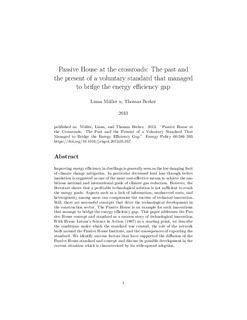| dc.contributor.author | Muller, Liana | |
| dc.contributor.author | Berker, Thomas | |
| dc.date.accessioned | 2017-11-01T08:53:12Z | |
| dc.date.available | 2017-11-01T08:53:12Z | |
| dc.date.created | 2013-06-20T09:28:30Z | |
| dc.date.issued | 2013 | |
| dc.identifier.issn | 0301-4215 | |
| dc.identifier.uri | http://hdl.handle.net/11250/2463347 | |
| dc.description.abstract | Improving energy efficiency in dwellings is generally seen as the low-hanging fruit of climate change mitigation. In particular decreased heat loss through better insulation is suggested as one of the most cost-effective means to achieve the ambitious national and international goals of climate gas reduction. However, the literature shows that a profitable technological solution is not sufficient to reach the energy goals. Aspects such as a lack of information, unobserved costs, and heterogeneity among users can compromise the success of technical innovation. Still, there are successful concepts that drive the technological development in the construction sector. The Passive House is an example for such innovations that manage to bridge the energy efficiency gap. This paper addresses the Passive House concept and standard as a success story of technological innovation. With Bruno Latour's Science in Action (1987) as a starting point, we describe the conditions under which the standard was created, the role of the network built around the Passive House Institute, and the consequences of exporting the standard. We identify success factors that have supported the diffusion of the Passive House standard and concept and discuss its possible development in the current situation which is characterized by its wide-spread adoption. | nb_NO |
| dc.language.iso | eng | nb_NO |
| dc.publisher | Elsevier | nb_NO |
| dc.rights | Attribution-NonCommercial-NoDerivatives 4.0 Internasjonal | * |
| dc.rights.uri | http://creativecommons.org/licenses/by-nc-nd/4.0/deed.no | * |
| dc.title | Passive House at the Crossroads: The Past and the Present of a Voluntary Standard That Managed to Bridge the Energy Efficiency Gap | nb_NO |
| dc.type | Journal article | nb_NO |
| dc.type | Peer reviewed | nb_NO |
| dc.description.version | acceptedVersion | nb_NO |
| dc.source.journal | Energy Policy | nb_NO |
| dc.identifier.doi | 10.1016/j.enpol.2013.05.057 | |
| dc.identifier.cristin | 1035440 | |
| dc.relation.project | Norges forskningsråd: 193830 | nb_NO |
| dc.relation.project | Egen institusjon: 11 | nb_NO |
| dc.description.localcode | © 2013. This is the authors’ accepted and refereed manuscript to the article. This manuscript version is made available under the CC-BY-NC-ND 4.0 license http://creativecommons.org/licenses/by-nc-nd/4.0/ | nb_NO |
| cristin.unitcode | 194,62,40,0 | |
| cristin.unitname | Institutt for tverrfaglige kulturstudier | |
| cristin.ispublished | true | |
| cristin.fulltext | postprint | |
| cristin.qualitycode | 1 | |

